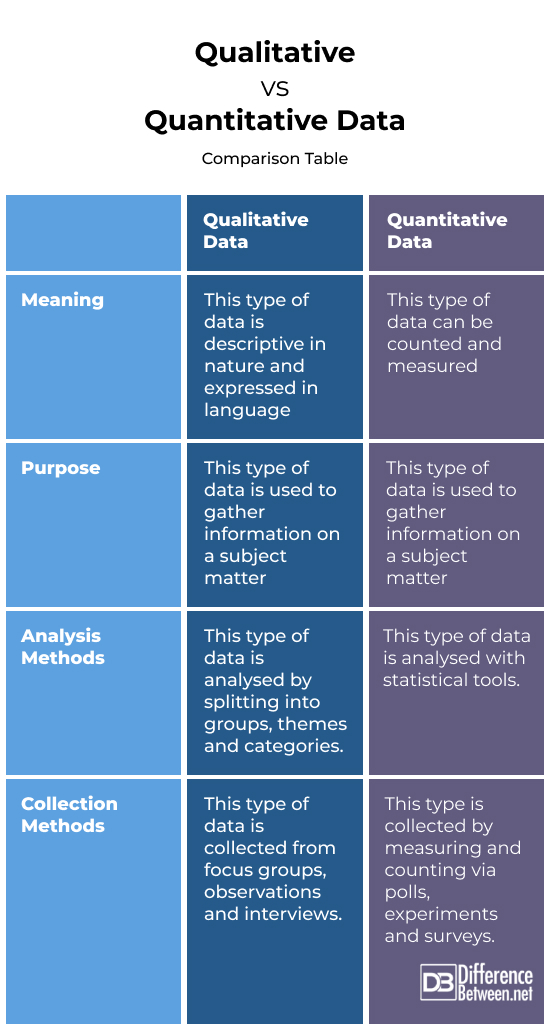Difference Between Qualitative and Quantitative
If you’re interested in data analysis, it’s crucial that you understand the difference between qualitative and quantitative data elements. These terms refer to the popular classes of data used during research. The truth is that understanding the differences and similarities between qualitative and quantitative can greatly impact the quality of your data research and analysis. That’s where we come in. This piece contains a detailed comparison of qualitative and quantitative data.

What is Qualitative Data?
Qualitative data is descriptive in nature and expressed with language, instead of numbers. This term describes any type of information that can’t necessarily be measured or counted. Instead labels are used to describe certain traits. It’s also important to note that qualitative data seeks to answer the question ‘why’ or ‘how,’ and is often used to investigate open-ended research where participants can truly express how they feel. Popular data collection methods include focus groups, interviews and observations.

What is Quantitative Data?
Quantitative data refers to any piece of information that can be quantified, i.e. it can be counted, measured and denoted by a numerical value. This type of data will tell you ‘how many,’ ‘how often,’ and ‘how much.’ Here are a few questions to help you identify quantitative data:
- How many students attended the last class?
- How often do customers visit your website?
- How much did our company spend last year?
To answer any of these questions, you’d need to review statistical evidence presented to you. By studying large amounts of data and identifying trends and patterns, it’s possible to identify trends related to any of the above-mentioned questions. Today, computers are designed with powerful algorithms capable of processing large volumes of data.
Possible Similarities Between Qualitative and Quantitative Data
It’s easy to think that there are almost no similarities between qualitative and quantitative data. But that’s not the case. Both type of data are more similar than you think.
First, qualitative and quantitative data are useful tools to compile information about different concepts. This information can be further split into sets and used for further decision making. While both are not applicable in the same scenario, they perform a similar function. Also, both can give you a rough idea of the contents of a large volume of data. Qualitative and quantitative data are renowned for asking questions that summarize the characteristics of large data sets.
What is the Difference Between Qualitative and Quantitative Data?
There are a few notable differences between qualitative and quantitative data in terms of collection, analysis and hypothesis methods. They include:
- Qualitative data relies on descriptive and relatable language while quantitative data relies on numbers.
- Qualitative data shows us why, what or how an action occurred under the influence of certain behaviors while quantitative data shows us how many, how much or how often an action occurred.
- Qualitative data displays unique and subjective details about a subject matter while quantitative data displays fixed and universal details.
- Qualitative data collection methods include interviews and observations while quantitative data relies on measuring and counting collection methods
- Qualitative data is analysed by splitting it into categories and groups while quantitative data is analysed with statistical methods.
Qualitative vs Quantitative Data: Comparison Table

Summary
During a research, qualitative and quantitative data are equally important to the authenticity of the final results. Hence, you need to learn to differentiate between them. Qualitative data has no structure and focuses on describing the scenario. On the other hand, quantitative data has a structured approach and focuses on creating numerical values for different elements of the research. Many researchers use qualitative data to lay a foundation for their work and rely on quantitative data for conclusive evidence.
FAQs
What are 3 examples of qualitative data?
Three common examples of qualitative data are religion, marital status and native language.
What’s the difference between quantitative and qualitative observations?
The main difference between quantitative and qualitative observations is that the former focuses on numbers while the latter uses detailed descriptions.
What are the 5 examples of quantitative research?
Five common examples of quantitative research include age, height, weight, group size, income.
Is gender qualitative or quantitative?
Gender is a qualitative type of data. It describes the psychological and physical traits associated with one sex (male or female).
What are 5 examples of qualitative and quantitative?
Five examples of qualitative are social class, religion, marital status, academic qualifications, and native language, while five examples of quantitative are income, monthly expenses, distance, time, and website load page speed.
What are the 6 example of qualitative research?
Six examples of qualitative research include observations, grounded theory, one-on-one interviews, phenomenology, focus groups and case study research.
What is qualitative and quantitative data in healthcare?
Qualitative data in health care refers to descriptive data, such as gender, blood group, marital status, treatment method, and social class while quantitative data refers to numerical data, such as age, height, weight, patient population, and number of equipment.
What is a quantitative example in healthcare?
Quantitative examples in healthcare include total population of patients, population with a blood group, population of medical practitioners, average age of medical practitioners, and average age of patients.
What is quantitative analysis in healthcare?
Quantitative analysis in the healthcare ecosystem refers to any mathematical and statistical approaches used to measure and evaluate data.
- Difference Between Schizophrenia and Psychosis - March 7, 2024
- Difference Between African and Asian Elephants - March 7, 2024
- Difference Between Sunscreen and Sunblock - February 15, 2024
Search DifferenceBetween.net :
1 Comment
Leave a Response
References :
[0]Image credit: https://www.canva.com/photos/MADF6kddcbI-qualitative-data-collection-tools/
[1]Image credit: https://www.canva.com/photos/MADesW8ev8U-data-analysis-developing-business-growth-strategy-/
[2]Monfared, J., & Derakhshan, H. (2015). Online) An Open Access. Indian Journal of Fundamental and Applied Life Sciences, 5(S2), 1111–1117. https://www.cibtech.org/sp.ed/jls/2015/02/143-JLS-S2-147-HOJATOLAH-COMPARISON%20-66.pdf
[3]McLeod, S. (2023, December 18). Qualitative Vs Quantitative Research Methods & Data Analysis. Simply Psychology. https://www.simplypsychology.org/qualitative-quantitative.html
[4]Ahmad, S., Wasim, S., Irfan, S., & Gogoi, S. (2019). Qualitative v/s Quantitative Research. ResearchGate. https://www.researchgate.net/publication/337101789_Qualitative_vs_Quantitative_Research

Very useful to give an idea
Thanks